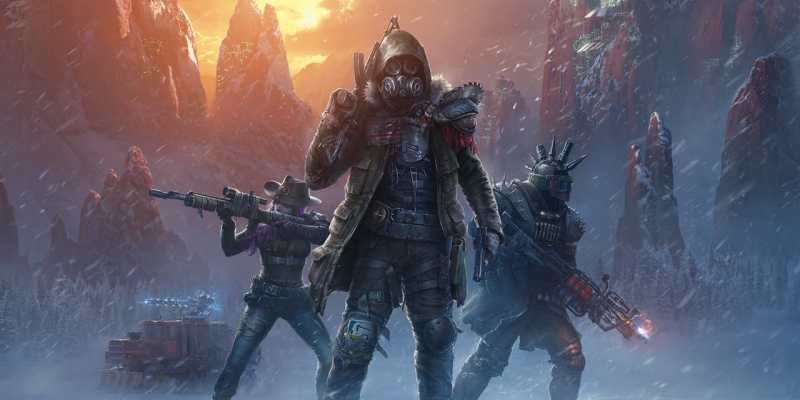The niche InXile Entertainment has carved out for Wasteland 3 makes a lot of sense. While Bethesda’s first-person Fallout 3 (2008) popularized the post-apocalyptic RPG and Obsidian’s Fallout: New Vegas (2010) married popular form to old-school sensibilities, Wasteland 3 is those old-school sensibilities. Turn-based, party-based, and isometric, with a few quality-of-life features and fancy post-processing, at first glance it’s exactly how I imagine a late ‘90s CRPG to look in 2020. But only at first glance, because on closer inspection, Wasteland 3 is simultaneously deeper and shallower than its ancestors.
Wasteland 3 is set in an alternate future 2100s, over 100 years after a nuclear war between the United States and USSR reduced the world to rubble. It picks up shortly after the events of Wasteland 2 (2014), which ended with the Desert Rangers – a paramilitary peacekeeping force led by a copyright-compliant version of Chuck Norris’ Walker, Texas Ranger – nuking their own base in Arizona to destroy a murderous AI. It leaves them weakened and desperate for resources, so they accept an offer for an alliance from the ruler of the seemingly prosperous Colorado in exchange for help capturing his three rebellious children. Things immediately go wrong, of course: The Ranger convoy sent to Colorado is ambushed and all but wiped out, and the survivors quickly discover that Colorado’s problems run much deeper than a few aristocratic brats.
It’s a welcome shift of focus from robot to human concerns, and it’s a suitably Shakespearean premise for a story that is first and foremost about the balance of power and the difficult choices that come with power. The Patriarch, Colorado’s ruler, presents himself as a benevolent dictator seeing his nation through a period of stabilization and transition towards democracy. But that period has dragged on for five decades, and the Patriarch’s penchant for luxury and oversized monuments to himself belie a man losing his grip on political reality and the shaky allegiances that secured his dominance. When the Patriarch leases a disused air force base to the Rangers as their HQ and gives them free rein to round up his wayward children, the game’s choice to follow his flag or build up an independent faction committed to the rule of law and constitutional values seems like a no-brainer.
It’s to the game’s great credit that early decisions reinforce this sense of self-righteous crusade by making it deceptively simple to take the moral high ground. Yet within just a few hours the consequences begin to bite, forcing follow-on choices that often amount to quick and dirty compromises of convenience, and sometimes catastrophic miscalculations, demonstrating the deceptively complex reality of wielding power.
Want to help some refugees that the Patriarch neglected by letting them live at the Ranger HQ? Sure, seems like the right thing to do. But as the HQ fills up with recruits, Rangers will complain that the refugees are taking up valuable barracks space. Don’t interfere and Rangers will mutiny or quit. Expel the refugees, and you’ll renege on your lofty ideals of protecting the weak and vulnerable. Compromise, and you’ll have to relocate the refugees to the brig to live alongside any prisoners you capture.
Plenty of modern RPGs tout their shades-of-gray choices and consequences, but with the exception of the unsurpassed choice system in Pathologic 2, I struggle to recall any recent game that implements them as well as Wasteland 3. Even after my choices led to a civil war within the Ranger HQ and I had to put several companions in front of a firing squad, I couldn’t say I would have been able to do better on another playthrough.

Wasteland 3’s grim politics are set in welcome contrast to a world that is full of oddball factions, dark humor, and countless pop culture references. The Gippers worship an AI simulation of Ronald Reagan; the Machine Commune is a collective of anarcho-communist robots; Los Payasos are militarized nihilists who dress as clowns because they believe the world is a joke. And so on and on.
After a while it becomes apparent that there is a formula at work here: Create a faction, give it a weird gimmick, and see how that fits with other factions and the player’s choices. While I can’t deny that it makes for a fascinatingly strange world that made me laugh (probably too much) at things like a cat addicted to cigarettes, fake Scottish accents, and surfer bro robots, this formula also makes for a world that feels contrived.
It’s difficult to view Colorado as anything other than a collection of bizarre locations for the player’s entertainment, rather than a place where people might actually live. In contrast to, say, the tilled fields of Fallout’s Shady Sands or the caravan drives of New Vegas, which are there almost exclusively for world-building detail, Colorado feels empty and lifeless. You encounter randomized merchants, visit a mine, help out at a bison ranch, rescue a family at a farmstead – all things that point to a wider society and economy, but they don’t feel like they exist apart from the player.
It doesn’t help that Colorado’s map, while appearing open, is really a warren of corridors gated by different levels of radioactive fallout. It’s traversed by means of an upgradable snow car, and the areas with the highest levels of radiation require either a late-game car upgrade to access safely or a lot of medication to treat the resulting radiation poisoning. It’s difficult to believe that anyone could live in such conditions, let alone maintain a society.

Between navigating the narrative and the world, the player commands up to six Rangers and non-Ranger NPCs (and occasionally the snow car, armed with a choice of cannons and bombs) in turn-based squad battles. The basic setup is reminiscent of X-COM, albeit with less depth of tactical options. Spend actions points on a basic attack, movement, ambush, cover, item use, or a special move earned by investing in certain skills and perks, and then wait for your enemy to do the same.
It comes with all the weird and entertaining idiosyncrasies typical of turn-based RPGs, such as watching someone try to punch a giant robot scorpion to death or running straight through a flaming field because that uses the least action points. And even on the Wastelander (normal) difficulty, combat can be equally rewarding and challenging, especially if your squad isn’t properly equipped for an encounter.
But there are also some very clear missed opportunities. Wasteland 2 released the same year as Divinity: Original Sin, a game lauded for reinventing the way encounters play out in turn-based RPGs and the way various systems and effects can be combined and stacked. Wasteland 3 chooses not to borrow any of its innovations.
Guns can stun, blind, maim or apply freezing, electric, and fire damage. Barrels can explode. Generators powering machinery turn on or off. But the combat remains largely unchanged from Wasteland 2.
Wasteland 3 can’t rely on its tech to smooth over its faults either. Sure, all the modern bells and whistles are here: ambient occlusion, bloom, screen space reflection, etc. All are highly customizable and on a reasonably powerful PC can be maxed out with a relatively steady 60 FPS at 4K. (I encountered one hard crash, one drop below 30 FPS that was fixed with a restart, and two graphical glitches during my playthrough.)

But the game has some serious technical problems with the way it records player decisions. To give one example, in an early part of the game, the player is given the choice of siding with a mob boss or with the local marshals. If the player sides with the mob boss, the boss sends some of his people to Ranger HQ as support. If the player sides with the marshals, they send some of their people instead. I sided with the mob boss then changed my mind and killed him, yet somehow I ended up with both the mobsters and the rangers at Ranger HQ for the rest of the story. These issues are pervasive, and InXile has already patched some of them, but they hurt the game’s strongest feature and exacerbate the sense that Colorado is not a real place.
The art direction and presentation are questionable too. While some might dig the brash font, the hugely oversized UI, the blazing blue box around dialogue choices, the ostentatious way the combat grid unfolds over the landscape at the start of battle, the not-quite-cartoon-but-not-quite-real character models, and the oversized location and snow car markers on the world map, I found it all a bit too much. Perhaps it works better on consoles, farther away from the screen, but too often I felt like I was in a post-apocalypse as imagined by NASCAR, rather than playing a true successor to Wasteland or a spiritual successor to Fallout.
That’s not to say that the presentation is always garish and over the top. This is one of the best voiced games in recent memory, and the delivery is often subtle and affecting. Some of the dialogue is presented in first-person, which lends weight and urgency to key scenes. (I just wish it had been possible to implement this feature more often.)

There is an option to build custom party members too; the ability to run around with a foul-mouthed Jersey-accented recreation of Brian May never got old for me. And all the menus – from flavor text for the yellow snow inventory item to the Sneaky Shit character skill – are infused with the same dark and endearingly dumb sense of humor as the rest of the game.
The problem is how frustratingly inconsistent things can be. Take the soundtrack, for example. Unlike the usual RPG fare, key battles are scored with well-chosen third-party country-and-western tracks. It works surprisingly well, but between these songs the game plods along to a kind of listless ambience that could have been plucked from any low-budget science fiction show. When the credits rolled, I was bewildered to learn that Wasteland 3 is scored by legendary composer Mark Morgan.
Ultimately, Wasteland 3 succeeds on its narrative, choice system, strong characters, and compelling factions. It stumbles in its lifeless world, inconsistent presentation, familiar gameplay, and technical side – it often feels like a snow-themed reskin of Wasteland 2, with many of that title’s limitations and janky systems. Nonetheless, designer Brian Fargo has here made the best post-apocalyptic RPG since Fallout: New Vegas. It’s just not as good as the one he made 23 years ago with Fallout.
